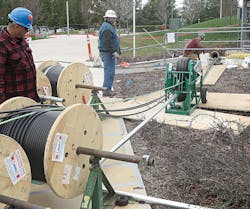When conducting indoor cable pulls during a shutdown or during new construction, do you follow the safety practices for temporary power and light? Violations of these practices can turn a cable pull into a tragedy, even if you do everything else right.
Also, if you're using a portable generator for power, try to locate it outdoors. If that isn't feasible, then don't rely on passive ventilation to magically dissipate the fumes.
Do you secure your cable spools so they won't come off their mountings? Using a cable pulling stand solves several potential safety problems while allowing the spools to rotate properly.
Whether you use a stand or go “old school” with a stick of electrical metallic tubing (EMT) or conduit stuck through the spool centers and supported on each end by empty spools, you need to make the rotation mechanically smooth. Avoid cable entry angles that might cause binding and think out the cable feed. Use the correct amount of lubricant at the correct intervals.
About the Author

Mark Lamendola
Mark is an expert in maintenance management, having racked up an impressive track record during his time working in the field. He also has extensive knowledge of, and practical expertise with, the National Electrical Code (NEC). Through his consulting business, he provides articles and training materials on electrical topics, specializing in making difficult subjects easy to understand and focusing on the practical aspects of electrical work.
Prior to starting his own business, Mark served as the Technical Editor on EC&M for six years, worked three years in nuclear maintenance, six years as a contract project engineer/project manager, three years as a systems engineer, and three years in plant maintenance management.
Mark earned an AAS degree from Rock Valley College, a BSEET from Columbia Pacific University, and an MBA from Lake Erie College. He’s also completed several related certifications over the years and even was formerly licensed as a Master Electrician. He is a Senior Member of the IEEE and past Chairman of the Kansas City Chapters of both the IEEE and the IEEE Computer Society. Mark also served as the program director for, a board member of, and webmaster of, the Midwest Chapter of the 7x24 Exchange. He has also held memberships with the following organizations: NETA, NFPA, International Association of Webmasters, and Institute of Certified Professional Managers.
